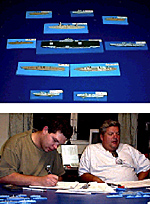
Tom Gallagher chose a Carrier battle using Seekrieg rules for the first wargame in his refurbished game room. The scenario was based on Guadalcanal. The Japa-nese had two carrier groups and an air base in the North, the US had two carrier groups and an airbase in the South. The Japanese also had a small scout fleet whose mission was to escort the invasion force to the US island base. The US fleet was tasked with destroying the Japanese carriers and stopping the invasion. I took command of the scout fleet and Japanese base. John Burke and newcomer Bob Goodheart controlled the carriers. Kirby Stiltner and Doug Gallagher shared the US fleet, with Tom acting as referee.
Most of the game was played out with each side plotting their ship movements and air patrols on maps. The maps were handed in to Tom at the end of each turn and he would announce if anything had been sighted. It was a very interesting system that created an effective fog of war and created a lot of tension. The Japanese plan was for the carriers to go down the slot in the middle of the table and find the US fleet while the Scout fleet tried to sneak down the West edge of the board. I launched a strike on the US base on turn one hoping to catch them unprepared. Thanks to a lot of luck we were able to inflict some damage, but it was a trick that wouldn’t work twice.
The next few turns were spent groping blindly for the enemy. The US scout planes were patrolling along the middle of the board, waiting for us to pass by. The Japanese guessed that the Americans carriers were waiting close to their air base where the land base and carrier based aircraft could help protect each other. John and Bob were able to sail well down the slot while I crept south.
Finally, in a quick dash forward, our carriers were in position for a massive strike on the Island. Since we hadn’t been located yet we could put all out planes into the strike. It was our best opportunity to win the scenario, and we fumbled on the goal line.
A bookkeeping error by Bob left half our fighter escort behind. Some confusion about how to handle the CAP added to our troubles. The result was that our fighters were shot down and our 40 bombers turned back without dropping a single bomb. We wouldn’t get another chance like that. It was very disappointing. If we could have neutralized the base my scout fleet could have moved quickly during the night and been in position for the invasion the next morning. There were bitter recriminations on the Japanese side of the board, and talk of seppuku.
Thoughts of what might have been dissolved quickly as Doug’s scouts located my scout fleet and all four carriers passed right by each other in the slot. Everyone planned massive strikes for the following turn. I decided to send the scout fleet racing back towards home in an effort to get out of range of the US planes and within range of our airbase for some CAP help. We sent every bomber we had to hit the US carriers, with all the fighters we could spare. The Americans reciprocated. Doug loaded the B-25s on the base with rockets and planned to skip bomb my scout fleet. Luckily I made it out of range so all eyes turned to the carrier fight.
We resolved the Japanese strike first. We elected to send all our attack aircraft at the Enterprise, hoping to overwhelm her AA defenses. As it turned out, the number of attacking aircraft has no effect on the AA fire, so this turned out to be a mistake. Still, dive bombers and torpedo bombers attacked from all directions. Our bombers took heavy losses but we scored two bomb hits and an amazing four torpedo hits. The Enterprise sank without a trace. The Americans divided their attacks, going after both carriers and the battleships. They damaged all four ships. A critical hit on one of the carriers destroyed her engine room. One of the battleships lost her powerplant.
The exchange left the issue still in doubt. Neither side looked like they were in a stong position to continue the fight. Both sides claimed to have the upperhand, but the battle ended there, so we’ll never know if either side could have pulled out a victory.
This was my first experience with Seekrieg’s carrier rules. My opinion is mixed. The initial part of the game was interesting, with both sides shadow boxing with hidden ship movements and plotted recon missions. The fog of war could have been enhanced if communications between the fleets had been restricted, and if Tom’s sighting reports had been made in secret. The downside to this part of the battle was the large amount of bookkeeping.
When it came to resolving the attacks the game bogged down. Part of this was because several of us were unfamiliar with the rules, and the rest were very rusty. A lot of if it had to do with the hyper detailed nature of the rules. The rules seemed to be heavy on the two things that I don’t like about naval wargaming - critical hits and bookkeeping. The rules seem a bit much for all but the most hard core naval wargamers.
Back to SJCW The Volunteer Winter 2000 Table of Contents
Back to SJCW The Volunteer List of Issues
Back to Master Magazine List
© Copyright 2000 by SJCW
This article appears in MagWeb (Magazine Web) on the Internet World Wide Web.
Other military history articles and gaming articles are available at http://www.magweb.com